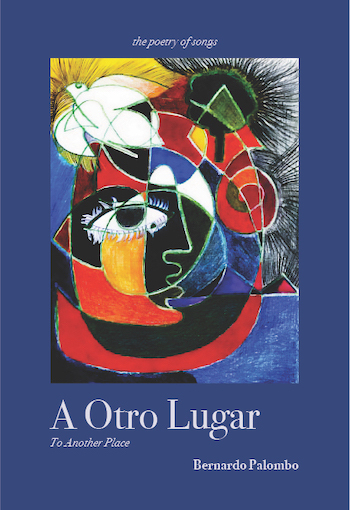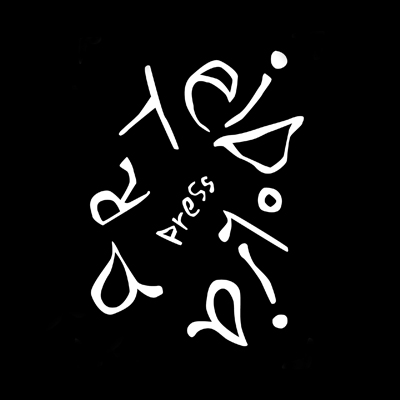A Otro Lugar / To Another Place
For more than half a century, Bernardo Palombo has juggled and bent languages to unite, teach, and inspire generations across the Americas. The lyrics of Palombo transcend page and stage while moving toward a loving testament for the global village to live a radical life of kindness and harmony. Palombo guides us to imagine a place far beyond this current world. In tender, dexterous verse, Palombo’s writing arranges an infinite circle that expands to make space and celebrate children, migrants, the forgotten, the Palomero, the earth, the water, each of us, the allness of the unknowable, and the beyond. These nuevapoemacanciones are heartwidening maps toward an existence of lightlove to birth a cosmos of memory, community, and assemble a future architecture of joy for others to follow. Read, sing, share this work. Join Palombo in the circle, he has already created room for you and me. –
Anthony Cody, Author of Rendering 2023 and Borderland Apocrypha 2020
A Otro Lugar — To Another Place – Bernardo Palombo – Arteidolia Press 2024 →
YOU CAN ORDER A OTRO LUGAR/TO ANOTHER PLACE HERE →
Intro by j. maya luz
El Canto Canta a Otro Lugar
The song sings of another place
desandar los recuerdos hasta mi vieja casa
untangle the memories to my old house
Bernardo used to remind me of something I said to him one of the first times that we met: “I love good stories.” He was one of the best tale-tellers. Listening to him spin threads while walking the streets of New York City was a quintessential activity for getting to know Bernardo Palombo. He could walk for miles. He said his stamina came from his time in military school, El Liceo Militar General Espejo in Mendoza, Argentina, that he attended from the ages of 11 through 16. There were few NYC streets that his feet had yet to mark after 55 years of walking them. He would untangle his memories to the ever-changing panorama of sights and sounds. I can still hear the rhythm of his gait, a gait that began his intuitive process that created patterns that transformed into rhythms, rhymes and words. And those patterns, the result of his movement in one place, gave him access to the memories of his movements in others: memories of Mendoza, Puerto Rico, the Dominican Republic, Cuba and his 45 years as the Artistic Director of a place called El Taller Latino Americano, where people from all over the world come to learn, to be with art, and to sing.
todo es chimera
all is chimera
When his feet struck the earth, it brought him to other places, places that gave him a far reaching vista from which he conjured images and ideas. He waxed philosophy, etymology, history, art and literature with his pace. He was mesmerized by culture, the positive aspects of Fernando Ortiz’s “transculturation”, the aesthetic expressions of often suppressed peoples who kept those cultures’ dignity celebratory, accessible and alive in art, music and poetry. He saw that suffering was everywhere, and each of us did what we could in our own lives to be able to survive. For Palombo, “all is chimera”: separations between us, the distances from one place to another, one experience from another, was an illusion. Culture was one way to form community and the bonds for alleviating some of that suffering. He felt that this was evident in a city like New York, with its “immigrant nature”, because we were all here seeking a better place.
Yo solo soy un ave errante, buscando lar donde anidar
I’m like a bird flying and wandering, seeking a land where I can live
Palombo was born in Mendoza, Argentina in 1948. He loved to tell a story about how he learned to talk in full sentences before he began to walk. It was a sweet explanation for his loquacious nature. Palombo was entranced by words, joyfully playing with rhyme and meter that was also influenced by music, which was a deep part of his regional culture. His artistic journey began as an adolescent poet, which earned him recognition and a prestigious prize from the Sociedad Argentina de Escritores de Mendoza. His winnings were taken away when it was revealed that he was a teenager, and worse, an unpublished poet. This was a critical moment for young Palombo, stirring his rebellious nature that was instinctually repelled by anything that was exclusive or pretentious, and in response he turned towards the song (el canto). He understood that it was the song that carried messages far and wide by easily breaking the barriers of culture and language, while being receptacles of stories, histories and messages that left an imprint on the soul’s memory. He felt that songs were powerful for the way they brought people together; songs were an important place for homage, history, memory and belonging.
Even though Palombo has been associated with the musical movement, La Nueva Canción, his repertoire is wide: from folk to salsa, from plena to decíma, lullaby to rock and roll. It is this eclecticism that makes him unique. He was compelled by an insatiable curiosity, a desire to listen to others and a playful nature that afforded him the ability to take creative risks. In fact for him, the only risk was to deprive his spirit of experimentation. His poem-songs are also a timeline for a remarkable life. He left Mendoza at the age of 19, already with some musical accolades from the song “Vendimiador”, lyrics that were set to music by Damián Sanchez and recorded by the vocal group Los Trovadores in 1965, when Palombo was just 17. With his family’s help and a community loan, he had enough money for a ticket to New York City, and once he arrived, he intended to raise the rest of the money he needed to get to France, to “become an intellectual” by staying with the writer Julio Cortazar. A few years earlier, his grandfather, Bernardo Blanco-Gonzales, the dean of Mendoza’s Facultad de Filosofía y Letras had invited Cortazar to live with him and teach at the university. That journey to France would never come to be. New York City in 1969 was a wondrous and exciting place. Once Palombo arrived, an adventure in music, language (Spanish and English), and activism began.
Y aunque el sur nació mi canto, se maduró en el Caribe
And though the south gave birth to my song, it matured in the Caribbean
New York is its own character in Palombo’s story. It was his university. The people he met, the sounds he heard, the activities he engaged in, were each integral to his development. Palombo became immersed in overlapping political worlds of the late 60s and early 70s. He was exposed to new music, new people, new ideas. Simultaneous to the sounds of folk and rock, there were surprises for this Mendocino: the music of the Caribbean, from Puerto Rico, Cuba and the Dominican Republic. He was captivated by the rhythms of these countries, another kind of folk from his native region. As part of the group, El Grupo, he traveled and was immersed in the musical legacies of Puerto Rico; later his work with the Center for Cuban Studies would give him entree to Cuba; in New York a connection to Café Protesta would strengthen his connection to the political song internationally; and in 1974 he would help to organize the festival Siete Días con el Pueblo (Seven Days with the People), in support of the workers union (CGT), in Santo Domingo, Dominican Republic during its most repressive government under the Balaguer regime. These lessons, most joyful, some tragic, fostered an outlook that became the mission of Palombo’s biggest project: El Taller Latino Americano. Founded in 1979, it is a place for dynamic thought, creativity for the sake of creativity, a place he imagined that could be a house for those who dared to dream, dared to be themselves, and dared to let their voices fly, like the best songs did.
conéctate al radio de tu corazón
connect to the radio in your heart
For him the song is a place: it is a location, a site, it describes cultures, histories and relationships from other times, other memories, that mix into us in the present and become ours in the here and now, on a continuum that is in constant change.
For him the song is a place: it is carried on the wind by instruments, voices and vibrations and is planted into a collective memory so transparent that sometimes we don’t even remember how it got there. It crosses borders and languages. It has new owners, new meanings and new memories associated with them. It is consistent only in its “transculturation”: its way of presenting the aesthetic version of the common experiences of its era, and making it culturally meaningful, spiritually significant, and politically resonant from place to place, and generation to generation.
The song is a need; it is absorbed deeply into us: into hearts, minds, and bodies, into hands and hips, shoulders and mouths. It gives us stories that were never written down. It teaches us the poems that we didn’t know existed, and don’t know yet how to read. And when we come together and sing them, we transform into a harmonic community that elevates our voices above all that is chimera, and brings us A Otro Lugar.
j. maya luz
New York City, 2024
Bernardo Palombo
the poetry of songs
Listen to the songs and learn about the collaborations involved with the music.
Use the QR Code or goto:
www.bernardopalombo.com/poesia
Escuche las canciones y conozca las colaboracionesinvolucradas con la música.
Utilice el código QR o vaya a la URL
A musician, poet, songwriter, artist, outspoken immigrants-integration advocate Bernardo Palombo, founder/director of the The Latin American Workshop, El Taller, achieved his first musical success when his song “Vendimiador” was recorded by the legendary Argentinean vocal group, Los Trovadores. In New York City he continued to write songs that have been recorded by some of the best-known exponents of Latin music in New York and Nueva Canción in South America including Mercedes Sosa, Philip Glass, Conjunto Libre and Lucecita Benitez. Palombo also became a musical consultant and composer for film and television, involving himself in such diverse and innovative projects as the Lucas/Coppola production of “Powaqqatsi”, the PBS show “Sesame Street”, and the film “Americas in Transition”.
YOU CAN ORDER A OTRO LUGAR/TO ANOTHER PLACE HERE →
ISBN: 979-8-9889702-6-2, 108 pages, $20.00





